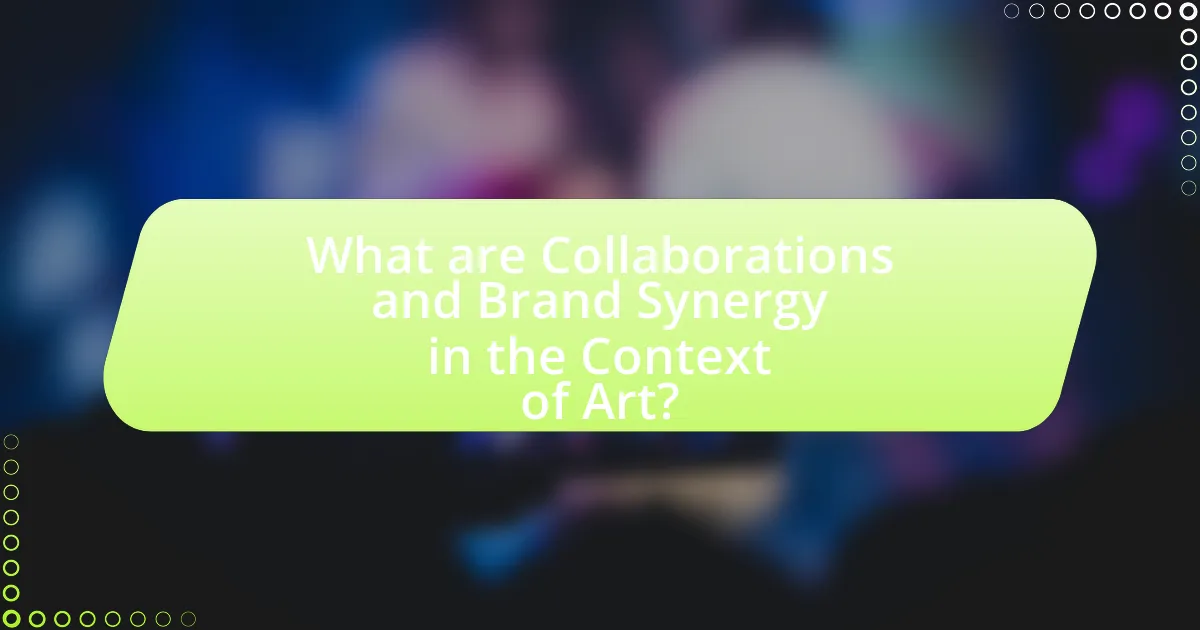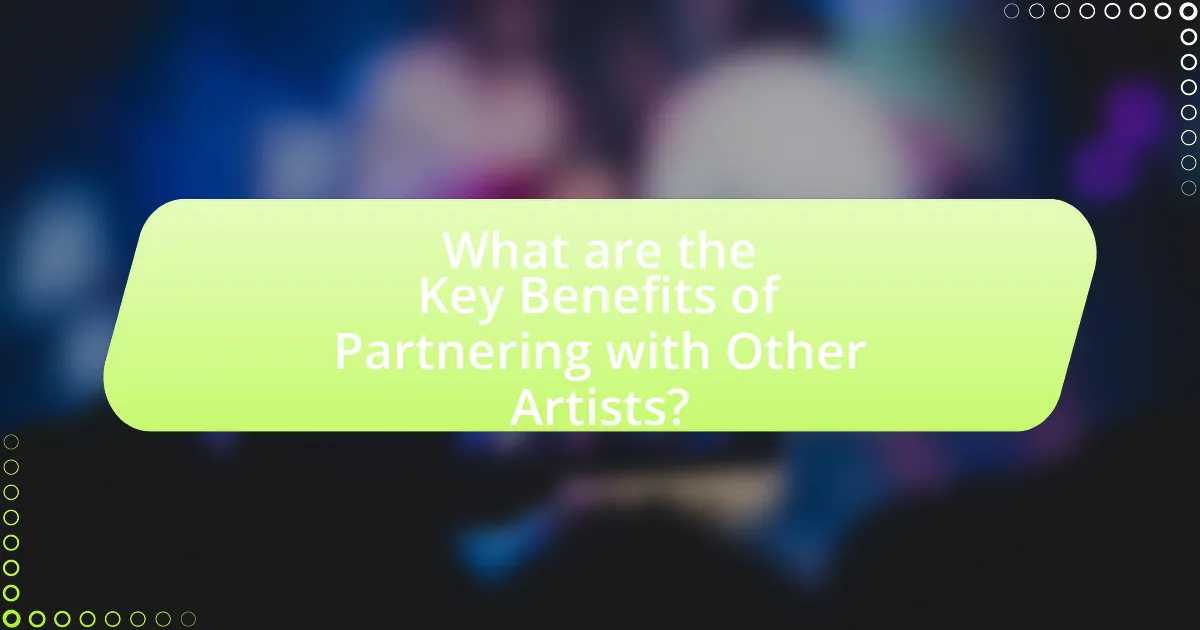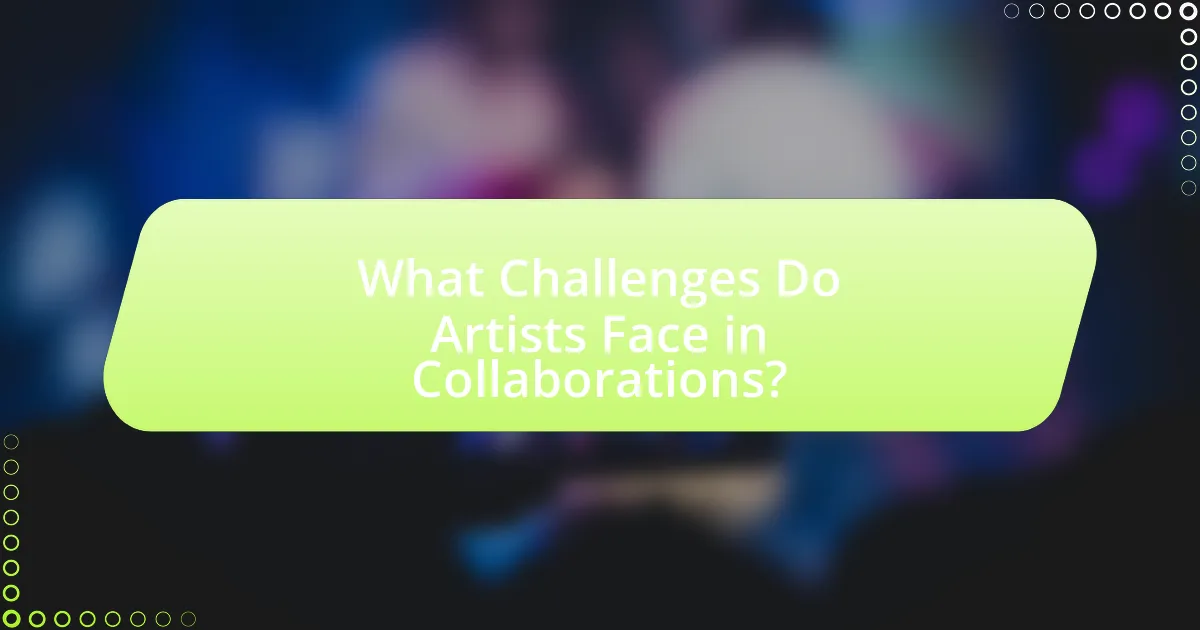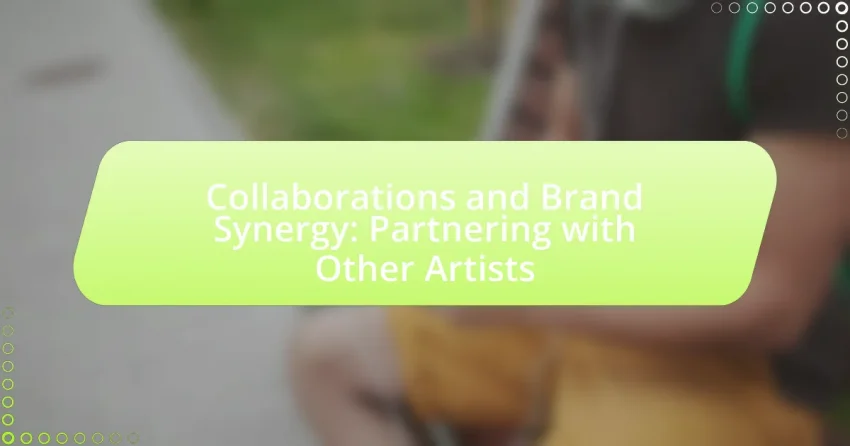Collaborations and brand synergy in the context of art involve partnerships between artists or between artists and brands, resulting in co-created works that enhance visibility and appeal for both parties. The article explores how these collaborations foster artistic expression, expand audiences, and create financial advantages while addressing the challenges artists face, such as differing creative visions and communication barriers. It also highlights the importance of brand identity and legal considerations in collaborative projects, along with best practices for effective communication and feedback integration. Overall, the article provides a comprehensive overview of the dynamics and benefits of artist collaborations in the contemporary art landscape.

What are Collaborations and Brand Synergy in the Context of Art?
Collaborations in the context of art refer to partnerships between artists or between artists and brands, where they co-create works that combine their unique styles and visions. Brand synergy occurs when these collaborations enhance the visibility and appeal of both parties involved, leading to a mutually beneficial relationship. For instance, when a well-known artist collaborates with a fashion brand, the artist gains access to a broader audience, while the brand benefits from the artist’s creative reputation, resulting in increased sales and brand loyalty. This dynamic is evident in successful partnerships like the collaboration between artist Takashi Murakami and Louis Vuitton, which not only elevated the brand’s artistic credibility but also expanded Murakami’s reach into the luxury market.
How do collaborations enhance artistic expression?
Collaborations enhance artistic expression by merging diverse perspectives and skills, resulting in innovative and multifaceted creations. When artists from different backgrounds collaborate, they bring unique techniques, ideas, and cultural influences that can challenge conventional norms and inspire new forms of expression. For instance, the collaboration between musicians and visual artists often leads to groundbreaking multimedia projects that redefine both art forms. Historical examples include the partnership between Andy Warhol and musicians like The Velvet Underground, which fused visual art with music, creating a new genre of artistic expression. Such collaborations not only expand the creative possibilities but also foster a sense of community and shared vision among artists, ultimately enriching the artistic landscape.
What types of collaborations exist among artists?
Various types of collaborations exist among artists, including joint projects, cross-disciplinary partnerships, and collective exhibitions. Joint projects involve two or more artists working together on a single piece or series, often blending their unique styles and techniques. Cross-disciplinary partnerships occur when artists from different fields, such as visual arts and music, collaborate to create a multifaceted experience. Collective exhibitions bring together multiple artists to showcase their work in a shared space, fostering a sense of community and shared vision. These collaborations enhance creativity and expand audiences, as evidenced by successful initiatives like the “Art Basel” fairs, which feature diverse artist collaborations and attract global attention.
How do different artistic styles influence collaboration outcomes?
Different artistic styles significantly influence collaboration outcomes by shaping the creative process, communication dynamics, and final product appeal. For instance, collaborations between artists with contrasting styles, such as realism and abstract art, can lead to innovative outcomes that attract diverse audiences, enhancing market reach. Research indicates that projects blending various artistic approaches often result in unique visual narratives, which can increase engagement and consumer interest. A study published in the Journal of Creative Behavior found that collaborations that embrace stylistic diversity tend to produce higher-quality work, as they leverage the strengths of each artist’s technique and perspective.
Why is brand synergy important for artists?
Brand synergy is important for artists because it enhances their visibility and market reach by aligning their personal brands with complementary partners. When artists collaborate, they can leverage each other’s audiences, resulting in increased exposure and potential sales. For instance, a study by Nielsen found that 70% of consumers are more likely to purchase a product when it is endorsed by a trusted source, highlighting the effectiveness of brand partnerships. This synergy not only amplifies their individual messages but also creates a more compelling narrative that resonates with fans, ultimately driving engagement and loyalty.
What role does brand identity play in artist collaborations?
Brand identity plays a crucial role in artist collaborations by ensuring that the partnership aligns with the values, aesthetics, and messaging of both artists involved. A strong brand identity helps to create a cohesive narrative that resonates with audiences, enhancing the overall impact of the collaboration. For instance, when two artists with complementary brand identities collaborate, they can leverage each other’s strengths to reach wider audiences and create more engaging content. This synergy often results in increased visibility and marketability, as seen in successful collaborations like those between musicians and fashion designers, where both parties benefit from the shared brand equity.
How can brand synergy lead to increased visibility for artists?
Brand synergy can lead to increased visibility for artists by combining their audiences and leveraging each other’s brand strengths. When artists collaborate, they tap into each other’s fan bases, which can significantly expand their reach. For instance, a study by Nielsen found that 70% of consumers are more likely to engage with a brand after seeing it associated with another brand they trust. This principle applies to artists as well; when two artists with established followings collaborate, they create a cross-promotional effect that enhances visibility. Additionally, joint marketing efforts, such as shared social media campaigns or co-branded merchandise, can amplify exposure and attract new fans, ultimately leading to greater recognition in the industry.

What are the Key Benefits of Partnering with Other Artists?
Partnering with other artists enhances creativity and expands audience reach. Collaborations often lead to innovative ideas that may not emerge in isolation, as diverse perspectives can inspire unique artistic expressions. Additionally, by combining fan bases, artists can access new markets and increase their visibility, which can lead to greater sales and opportunities. For instance, the collaboration between artists like Jay-Z and Linkin Park resulted in the successful album “Collision Course,” which introduced both artists to each other’s audiences, demonstrating the tangible benefits of such partnerships.
How do collaborations expand an artist’s audience?
Collaborations expand an artist’s audience by leveraging the fan bases of both artists involved. When two artists collaborate, they introduce each other to their respective audiences, which can lead to increased visibility and new followers. For instance, a study by Nielsen Music found that collaborations can result in a 30% increase in streaming numbers for both artists, as fans are often curious to explore the work of the other artist. This cross-pollination of audiences not only broadens reach but also enhances engagement, as fans are more likely to share and promote the collaborative work across social media platforms.
What strategies can artists use to reach new demographics through collaborations?
Artists can reach new demographics through collaborations by strategically partnering with creators from different genres or cultural backgrounds. This approach allows artists to tap into the established fan bases of their collaborators, thereby expanding their audience reach. For instance, a pop artist collaborating with a hip-hop artist can attract listeners from both genres, effectively broadening their demographic appeal.
Additionally, artists can leverage social media platforms to promote their collaborations, utilizing targeted advertising to reach specific demographic groups. According to a study by the Pew Research Center, 72% of adults use social media, making it a powerful tool for artists to engage with diverse audiences.
Furthermore, collaborating with influencers or brands that resonate with different demographics can enhance visibility and credibility. For example, a collaboration with a popular lifestyle brand can introduce an artist to a new audience that may not have previously engaged with their music.
These strategies demonstrate how collaborations can serve as a vehicle for artists to connect with and grow their fan base across various demographics.
How does collaboration foster community among artists?
Collaboration fosters community among artists by creating shared experiences and networks that enhance creativity and support. When artists work together, they exchange ideas, techniques, and resources, which leads to a richer artistic environment. This interaction not only builds relationships but also encourages a sense of belonging and mutual support, as evidenced by collaborative projects like artist collectives and joint exhibitions that have historically strengthened local art scenes. For instance, the Harlem Renaissance exemplified how collaboration among artists, writers, and musicians cultivated a vibrant community that influenced American culture.
What financial advantages can arise from artist partnerships?
Artist partnerships can lead to increased revenue through shared resources, expanded audience reach, and enhanced brand visibility. By collaborating, artists can pool their marketing budgets, reducing individual costs while maximizing promotional efforts. For instance, a joint project can attract fans from both artists, effectively doubling the potential customer base. Additionally, partnerships can create unique products or experiences that command higher prices, as seen in successful collaborations like those between musicians and fashion brands, which often result in limited-edition merchandise that sells at a premium. This synergy not only boosts sales but also strengthens brand identity, making the partnership financially advantageous.
How can shared resources reduce costs for collaborating artists?
Shared resources can significantly reduce costs for collaborating artists by allowing them to pool their financial, material, and human resources. When artists collaborate, they can share expenses related to studio space, equipment, and promotional activities, which lowers individual financial burdens. For instance, a study by the National Endowment for the Arts found that collaborative projects often lead to a 30% reduction in production costs due to shared overhead and resource allocation. This collaborative approach not only enhances creativity but also maximizes the impact of their combined efforts while minimizing expenses.
What revenue streams can emerge from successful collaborations?
Successful collaborations can generate multiple revenue streams, including shared merchandise sales, joint concert tours, and co-branded products. For instance, when artists collaborate on a song, they can create exclusive merchandise that features both brands, leading to increased sales. Additionally, joint concert tours allow for shared ticket revenue, maximizing audience reach and profitability. Co-branded products, such as limited edition albums or collaborative fashion lines, can also attract fans from both artists, further enhancing revenue potential. These strategies have been proven effective in the music industry, as seen with successful partnerships like Jay-Z and Beyoncé’s “On the Run Tour,” which generated significant ticket sales and merchandise revenue.

What Challenges Do Artists Face in Collaborations?
Artists face several challenges in collaborations, including differing creative visions, communication barriers, and unequal contributions. Differing creative visions can lead to conflicts over artistic direction, as each artist may have unique ideas and styles that do not align. Communication barriers often arise from misunderstandings or lack of clarity, which can hinder the collaborative process. Additionally, unequal contributions can create tension, as some artists may feel they are contributing more than others, leading to feelings of resentment. These challenges can ultimately impact the success and harmony of the collaborative project.
How can creative differences impact collaborative projects?
Creative differences can significantly impact collaborative projects by leading to conflicts that hinder progress and affect the overall outcome. When artists or team members have varying visions, styles, or approaches, it can create tension and miscommunication, which may result in delays or a lack of cohesion in the final product. For instance, a study published in the Journal of Creative Behavior found that while diverse perspectives can enhance creativity, they can also lead to misunderstandings that impede collaboration if not managed effectively. Therefore, addressing and reconciling these differences is crucial for maintaining a productive collaborative environment.
What strategies can artists employ to resolve conflicts during collaborations?
Artists can employ open communication as a primary strategy to resolve conflicts during collaborations. By fostering an environment where all parties feel comfortable expressing their thoughts and concerns, artists can address misunderstandings before they escalate. Additionally, establishing clear roles and responsibilities at the outset of a collaboration helps to minimize confusion and conflict. Research indicates that collaborative projects with defined expectations lead to higher satisfaction and fewer disputes among team members. Furthermore, utilizing conflict resolution techniques such as active listening and compromise can facilitate a more harmonious working relationship, allowing artists to focus on their creative goals rather than interpersonal issues.
How do differing work ethics affect collaboration outcomes?
Differing work ethics significantly impact collaboration outcomes by influencing communication, productivity, and overall project success. When team members have contrasting work ethics, such as varying levels of commitment, punctuality, and quality standards, misunderstandings and conflicts can arise, leading to decreased efficiency. For instance, a study published in the Journal of Business Research found that teams with aligned work ethics reported higher satisfaction and performance levels compared to those with discrepancies in their work approaches. This alignment fosters trust and enhances collaborative synergy, ultimately resulting in more successful partnerships in creative endeavors.
What legal considerations should artists be aware of when collaborating?
Artists should be aware of copyright, contract agreements, and liability issues when collaborating. Copyright laws protect the original works of artists, meaning that any collaborative creation must clearly define ownership rights to avoid disputes. Contract agreements should outline the roles, responsibilities, and profit-sharing arrangements among collaborators, ensuring that all parties are legally protected and aware of their obligations. Additionally, liability issues may arise if one artist’s actions lead to legal claims, so it is crucial to include indemnification clauses in contracts to protect against potential legal repercussions.
How can contracts protect the interests of all parties involved?
Contracts protect the interests of all parties involved by clearly outlining the rights, responsibilities, and expectations of each party. This legal framework minimizes misunderstandings and disputes by specifying terms such as payment, deliverables, timelines, and intellectual property rights. For instance, a well-drafted contract can include clauses that address profit sharing, credit attribution, and dispute resolution mechanisms, ensuring that all parties have a clear understanding of their roles and benefits. By providing a formal agreement, contracts serve as a safeguard against potential conflicts, thereby fostering trust and collaboration among artists.
What are the implications of copyright in collaborative works?
Copyright in collaborative works implies that multiple creators may share ownership rights, which can complicate the management and distribution of those rights. In collaborative projects, each contributor typically retains rights to their individual contributions, while also granting certain rights to the collective work. This shared ownership can lead to disputes over usage, licensing, and revenue distribution, as seen in cases like the “Blurred Lines” lawsuit, where the court ruled on the extent of copyright infringement among collaborators. Clear agreements outlining the rights and responsibilities of each party are essential to mitigate potential conflicts and ensure fair compensation.
What Best Practices Should Artists Follow for Successful Collaborations?
Artists should prioritize clear communication for successful collaborations. Establishing open dialogue ensures that all parties understand their roles, expectations, and creative visions. Research indicates that effective communication can enhance collaboration outcomes, as seen in studies showing that teams with strong communication skills are 25% more productive. Additionally, artists should set mutual goals to align their creative efforts, which fosters a sense of shared purpose. This approach is supported by findings from the Journal of Creative Behavior, which highlight that collaborative projects with defined objectives lead to higher satisfaction and better results. Lastly, artists must respect each other’s creative processes and provide constructive feedback, as this nurtures a positive working environment and encourages innovation.
How can artists effectively communicate their vision during collaborations?
Artists can effectively communicate their vision during collaborations by utilizing clear and open dialogue, visual aids, and structured feedback sessions. Clear dialogue ensures that all parties understand each other’s ideas and expectations, which is crucial for aligning creative goals. Visual aids, such as sketches or mood boards, help convey abstract concepts in a tangible way, making it easier for collaborators to grasp the intended vision. Structured feedback sessions allow for constructive criticism and adjustments, fostering a collaborative environment where ideas can evolve while staying true to the original vision. These methods are supported by studies indicating that effective communication enhances teamwork and creativity in collaborative projects.
What tools can facilitate better collaboration among artists?
Digital collaboration tools such as Slack, Trello, and Google Workspace can significantly enhance collaboration among artists. Slack provides real-time communication and file sharing, allowing artists to discuss ideas and share work instantly. Trello offers a visual project management system that helps artists organize tasks and track progress collaboratively. Google Workspace enables artists to create, edit, and share documents and presentations in real-time, fostering seamless collaboration on creative projects. These tools are widely adopted in creative industries, demonstrating their effectiveness in facilitating teamwork and enhancing productivity among artists.
How can feedback be constructively integrated into collaborative processes?
Feedback can be constructively integrated into collaborative processes by establishing a structured framework for communication that encourages open dialogue and active listening. This framework should include regular check-ins, where team members can share their insights and suggestions in a safe environment, fostering a culture of trust and respect. Research indicates that teams that engage in continuous feedback loops are 30% more effective in achieving their goals, as they can quickly adapt and refine their strategies based on collective input. By utilizing tools such as collaborative platforms and feedback sessions, teams can ensure that all voices are heard, leading to more innovative and cohesive outcomes in collaborative projects.
